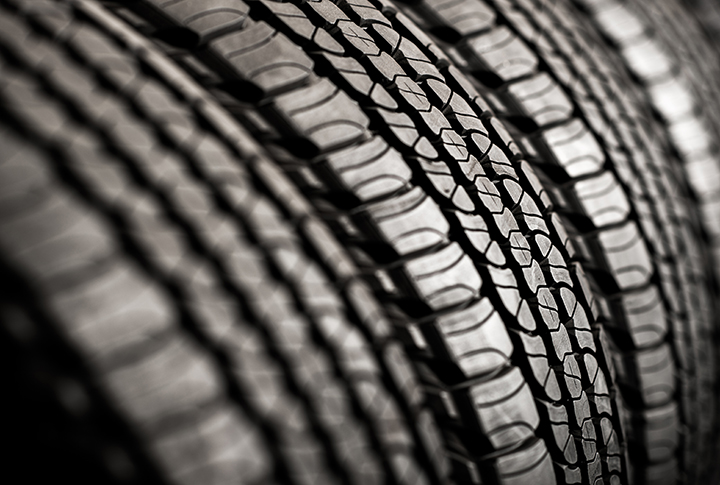According to the National Highway Traffic Safety Administration, there are 11,000 tire-related crashes on our roadways every year, under-inflated tires being the overwhelming causes of these accidents. Here are some tips to help avoid a dangerous situation, and what to do if you’ve been in an accident due to another’s vehicle having tire failure.
Tires, even spares, should be inspected regularly, preferably on a monthly basis. As the weather gets colder, tire air pressure will decrease, even without defect. Your inspection should focus on inflation pressure, tread wear, and tire damage. If you’ve noticed anything wrong, take your vehicle to a tire shop. They will be able to fix the problem by replacing the tire or by providing additional services, like rotation, balancing, and alignment.
Check Tire Pressure Regularly
Since 2005, all passenger vehicles and light trucks sold in the U.S. are equipped with a Tire Pressure Monitoring System (TPMS). It will either light a message when the pressure is too low in a tire or tell you the exact pressure of each tire. If you see a low-pressure warning, address it immediately. If you don’t know the recommended pressure for your tires, you can find it on the Tire and Loading Information placard, usually located on the driver’s side doorjamb of your vehicle. Do not inflate your tires to the “maximum” inflation pressure (MAX. PRESS.) labeled on your tire’s sidewall.

TPMS is not the only way to keep track of your tire pressure. Some experts recommend using a manual or “stick-style” pressure gauge as its a reliable way to measure tire pressure. Some air pumps will monitor how much air is in a tire and stop filling when it gets to the specified inflation pressure.
While low tire pressure is the most significant cause of tire-related accidents, over-inflated tires can also cause a problem. Tires with too much air wear tire treads prematurely and unevenly, or can cause bulging along the tire walls leading to catastrophic tire failure. Remember that the TPMS does not detect over-inflated tires.
It’s suggested that everyone keep a manual gauge in their vehicle and check tire pressure regularly rather than rely solely on TPMS.
Check for Worn Treads
Worn tire treads are also a major cause of tire failure. All tires have a bar in the groove that is molded to a height of 2/32nd of inch. In certain circumstances, reaching the “wear bar” will cause noise from a tire to alert the driver that the tire is near the end of its life.
If the bridge in the groove is level with the top of the tread then it’s time to change the tire. An easy trick is to stick a penny in the groove of the tire with Abraham Lincoln facing you. If you can see the entire top of Lincoln’s head when the penny is placed in the groove, it’s time to replace your tires.

It’s also a good idea to check for uneven tire wear. This could be a sign of mechanical problems such as a wheel out of alignment or worn suspension. The best practice is to have your tires rotated every 3,000 to 4,000 miles or during every oil-change to prevent uneven wear.
Perform Regular Visual Inspections
There can be visible signs of tire problems well before the pressure drops or the treads wear down, and the best way to detect early problems is to regularly look over your tires or take your vehicle to a tire dealer.
You should look for damage to the sidewall of the tire. You might notice a bulge in the sidewall, missing pieces of rubber, or a deep abrasion from hitting a curb. Also look for nails or other objects lodged into the tread of the tires. The object may not cause immediate loss of pressure but could cause a slow flat. If you notice a chunk of missing rubber that is bigger than a dime, be cautious; the tire is probably headed for failure.
Watch out for Old Tires
Did you know every tire has a birthday stamped on it?

Tire manufacturers warn that tires aged six years old or older need to be replaced because its rubber could degrade and fail.
Professional drivers are required to check truck tires daily. We’ve all seen big pieces of tire along the side of the highway. If professional drivers can miss an impending tire failure, the rest of us can too. Regular tire checks are the best prevention against this type of catastrophe.
What to do if You’ve Been in an Accident
If you’re in an accident due to a tire blowout or other tire issue, there are a couple steps to take.
1. Alert the police. You should always get a police report of the accident, no matter the cause. In this case, make sure to tell the police what you observed in the crash including tire issues so they can note it in the accident report.
2. Take pictures. While you may be disoriented after the accident, pictures can be vital to your claim. Take pictures of the treads, the manufacture date, and anything that doesn’t look right with the tire.
3. Call a personal injury attorney. Proving that a wreck was caused by a tire failure requires special expertise, because even new tires can be damaged in a wreck. Whether tire damage happened before or after a crash will be a contested issue in an alleged tire failure case.
If you are hurt in a car accident, call The S.E. Farris Law Firm. With more than 30 years of experience, we can get you the compensation you deserve. You can reach us at 314-252-9937, or send us a message to arrange a free consultation.

